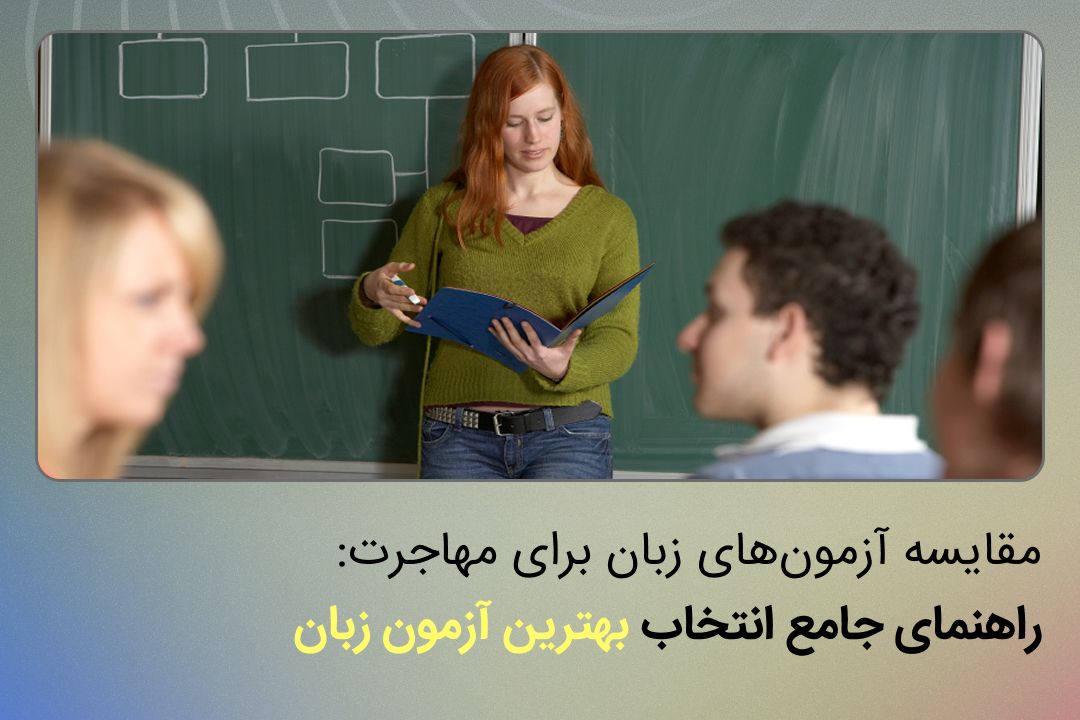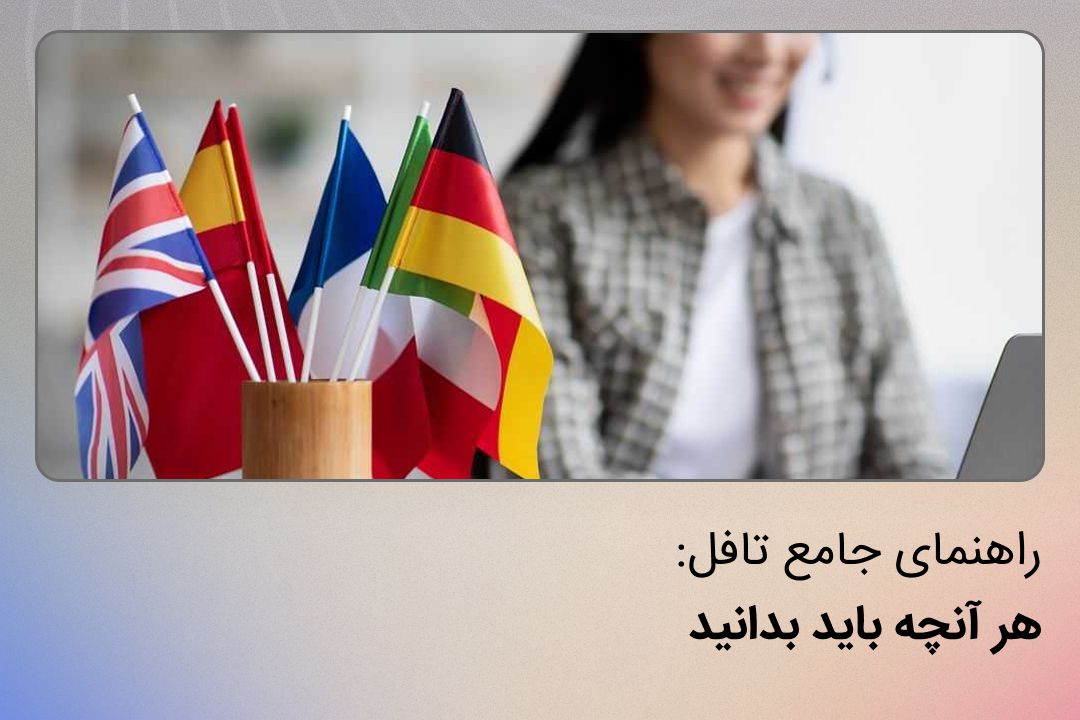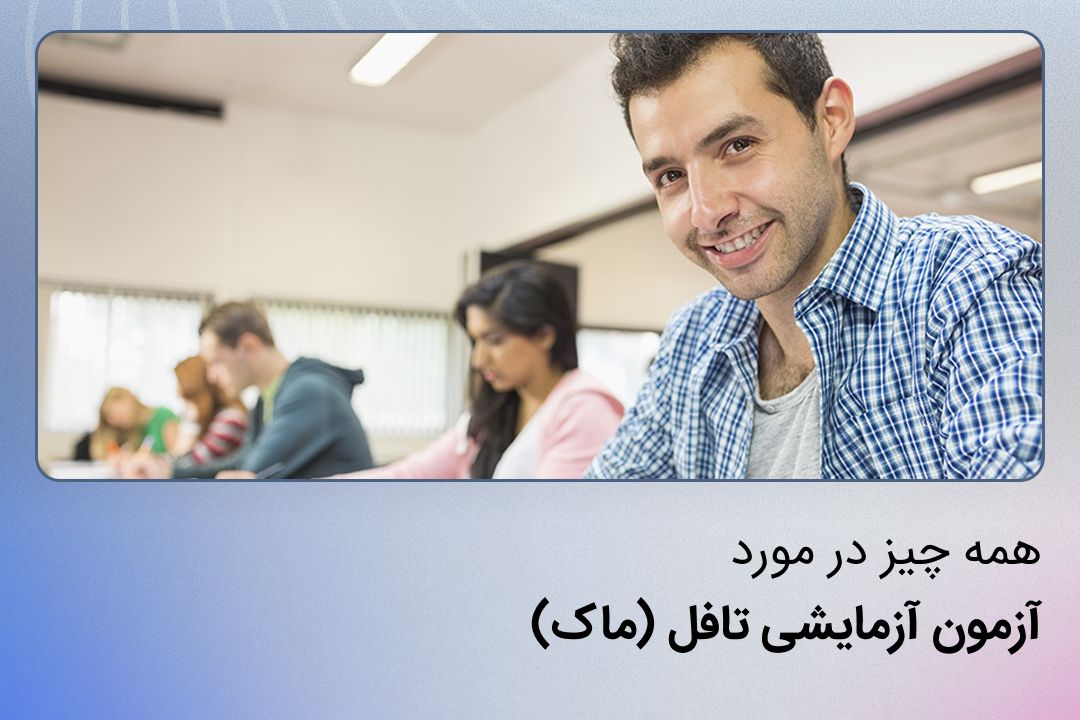مقدمه
بخش ریدینگ اولین بخش آزمون تافل است. شما دو مقاله علمی (هرکدام حدود 700 کلمه) خواهید خواند و به 10 سوال درباره هرکدام پاسخ خواهید داد. 36 دقیقه برای خواندن متن دو مقاله و پاسخ دادن به تمام سوالات در اختیار دارید.
در این مقاله صفر تا صد آشنایی جامع با بخش ریدینگ آزمون تافل از جمله فرمت، موضوعات پرتکرار، استراتژیهای مدیریت زمان، معرفی و ارائه استراتژی برای حل انواع سوالات ریدینگ و یک نمونه کامل آزمون ریدینگ به همراه پاسخ ارائه خواهند شد.

برای دسترسی به جدیدترین نمونه سوالات آزمون اصلی تافل (نئو و تی پی او) وارد سایت تست هلپر شوید.
موضوعات پرتکرار در بخش ریدینگ تافل

مقالات در بخش ریدینگ تافل حدود 700 کلمهاند و سطح دشواری متون در مقیاس فلش-کینکید بین 30 تا 50، یعنی در سطح محتوای کتاب درسی دانشجویان سال اول دانشگاه است. تحقیقاتی روی مجموعه های در دسترس عموم و منابع اصلی آماده سازی آزمون تافل برای بخش ریدینگ انجام شده تا به صورت دقیق و علمی ببینیم کدام موضوعات دانشگاهی بیشترین تکرار را در ریدینگ دارند. تحقیقات طیف گستردهای از منابع از جمله موارد زیر را شامل میشود:
- The Official Guide to the TOEFL
- The Official iBT Tests Vol. 1
- The Official iBT Tests Vol. 2
- The free practice test on ETS.org
- The TOEFL PDF sets on ETS.org
- The Propell Workshop Teacher’s Book
که در مجموع شامل 47 متن هستند.
هر متن ریدینگ از نظر موضوع طبقه بندی شده و روی عناوین موضوعی پرتکرار تمرکز شده است.
در هر صورت، نتیجه تحقیق بصورت زیر است:
موضوع | تعداد تکرار متن |
تاریخ | 16 |
جانورشناسی | 7 |
جغرافیا | 5 |
زیست شناسی | 4 |
زمین شناسی | 3 |
روان شناسی | 3 |
زیست بوم شناسی | 2 |
معماری | 1 |
اخترشناسی | 1 |
جامعهشناسی | 1 |
آموزش | 1 |
انسان شناسی | 1 |
هنر | 1 |
دیرینه شناسی | 1 |
همانطور که میبینید، تاریخ با اختلاف پرکاربردترین حوزه موضوعی در بخش ریدینگ است. جانورشناسی نیز نسبتاً رایج است.
چند نکته دیگر هم هست که شایان ذکرند:
- متنهای مربوط به تاریخ اغلب بر تاریخ انسانهای اولیه و تمدنهای اولیه تمرکز دارند.
- تاریخ سیاسی نیز تا حدودی رایج است.
- یکی از متنهایی که به عنوان "زمینشناسی" علامتگذاری شده بود، در واقع درباره تاریخ زمینشناسی بود.
- همچنین، متن مربوط به اخترشناسی درباره تاریخ اخترشناسی بود. کمی تاریخ بخوانید!
توجه داشته باشید که تاریخ با اختلاف زیادی رایجترین موضوع ریدینگ به شمار میرود. پس حتما هرچقدر میتوانید متون و مقالات تاریخی بخوانید. تاریخ حتی به موضوعات دیگر نیز نفوذ مییابد، مثلا یک ریدینگ درباره زمینشناسی ممکن است هم زمان درباره تاریخ زمینشناسی نیز باشد.
به خاطر داشته باشید که مقالات همه سطح مقدماتی دارند، پس نیازی به پیشزمینهی علمی برای درک و پاسخ به سؤالات نیست. البته داشتن پیشزمینهی علمی هرگز بی فایده نیست. سایت Science News منبع بسیار خوبی برای مقالات کوتاه است. اگر یک اصطلاح بسیار فنی در مقاله استفاده شده باشد، ممکن است تعریف کوتاهی از آن در پاورقی ارائه شده باشد.
برای دسترسی به جدیدترین نمونه سوالات آزمون اصلی تافل (نئو و تی پی او) وارد سایت تست هلپر شوید.
انواع سوالات در بخش ریدینگ

هر ریدینگ شامل 9 سؤال چند گزینهای (هر کدام یک نمره) و یک سؤال طولانیتر همراه با جدول یا نمودار (دو یا سه نمره) میآید.
میتوانید هر سؤال چندگزینهای را با بررسی یک پاراگراف مشخص، که در کنار سؤال نشان داده میشود، پاسخ دهید. سؤال جدول یا نمودار شامل جزئیاتی از کل مقاله خواهد بود.
سوالات چند گزینه ای
1- یافتن پاسخ بر اساس حقایق موجود در متن (Factual Information Questions)
این سؤالات از شما میخواهند جزئیات یا اطلاعات خاصی را که در ریدینگ ذکر شده پیدا کنید. 4 گزینه به شما داده میشود که 1 یا 2 تای آنها درست هستند. اگر 2 گزینه درست وجود داشته باشد، باید هر دو گزینه درست را انتخاب کنید تا نمره بگیرید.
این دسته سوالات به این شکل ارائه میشوند:
According to the paragraph, why did X…
The author’s description of X mentions which of the following?
برای پاسخ به این سؤالات، دقیقا به دنبال اطلاعات خواسته شده بگردید. گزینهای را که صرفا قسمتی از آن در مقاله آمده است، انتخاب نکنید. گزینههای نادرست اغلب شامل جزئیاتی هستند که در مقاله آمدهاند، اما به اطلاعات خواسته شده در سؤال مربوط نیستند.
این سبک سوال، رایجترین نوع سؤال در بخش ریدینگ میباشد. در هر ریدینگ بین دو تا سه سؤال Factual Information وجود خواهد داشت.
این هم یک نمونه:
The city’s growth as an important population center was also a result of its ability to establish and maintain economic links with communities as far away as the Great Lakes to the north and the Gulf Coast to the south. This was achieved through the trade of such exotic items as copper, chert, and seashells. Chert, most notably, was used in the production of hoes, a high demand tool for farmers around Cahokia and other Mississippian centers. Recent research on chert tools discovered at the Silvernail settlement site near modern day Minnesota found that the raw materials used to construct some of them originated near Cahokia.
According to paragraph 5, what has recent research on chert tools found at the Silvernail settlement site revealed?
Chert tools were started to be used after Cahokia became an important city.
The residents of Cahokia were the only producers of farming tools in the area.
Some of the tools used by people at the Silvernail settlement were made of materials from the area near Cahokia.
Agricultural tools were exchanged with people at the Silvernail settlement for copper and seashells.
2- یافتن گزینهی غلط بر اساس حقایق موجود در متن (Negative Factual Information Questions)
این سؤالات از شما میخواهند اطلاعات یا جزئیات خاصی را که در مقاله ذکرنشده است شناسایی کنید. این دسته سوالات، معمولا این گونه ارائه میشوند:
According to the passage, which of the following is NOT true of X?
The author’s description of X mentions all of the following EXCEPT…
In paragraph X, each of the following is mentioned about Y, EXCEPT…
این سؤالات بسیار وقتگیر هستند، زیرا باید کل پاراگراف را بسیار دقیق بخوانید. برای حل این نوع سؤالات وقت بیشتری نسبت به بقیهی سوالات چندگزینهای در نظر بگیرید.
این نوع سؤال نسبتا رایج است. انتظار میرود در هر ریدینگ یک تا دو مورد از این نوع سوال داشته باشید.
برای نمونه:
The ancient city of Cahokia was located at a site very close to modern St. Louis in the United States. At its apex from A.D. 1100 to 1200, Cahokia covered about 16 square kilometers and probably had a population that peaked at around 15,000. Excavations of the city have revealed that it contained a large number of public plazas that were separated by at least 120 man-made earthen mounds, the largest of which was topped by a major temple. Remains have also been found of an elaborate copper workshop that produced sophisticated metal goods likely traded with both nearby and distant settlements. Moreover, the city is noted for its significant economic and spiritual contacts with other communities in the Mississippi area. Although the inhabitants left no written records beyond symbols on pottery, shells, wood and stone, the remains of this elaborately planned community suggest that it was home to a complex society that had great influence over a large geographic area.
In paragraph 1, each of the following is mentioned as a feature of the city of Cahokia between A.D 1100 to 1200 EXCEPT:
Man-made mounds
Several large temples
A manufacturing workshop
Many public plazas
3- سوالات استنباطی (Inference Questions)
برای پاسخ به سؤالات استنباطی، باید ارتباط منطقی بین جزئیات متن و مطالبی که در متن ذکر شدهاند برقرار کنید. این سؤالات اغلب به این شکل ارائه میشوند:
What can be inferred from paragraph X about Y?
The author of the article implies that X…
از انتخاب گزینههایی که فقط حاوی برخی از کلمات ارائه شده در متن مقاله هستند، اجتناب کنید. به دنبال جزئیاتی در مقاله بگردید که روابط علت و معلولی یا توالی رویدادها را بیان میکنند. احتمال میرود یک سؤال از این نوع در هر ریدینگ داشته باشید.
برای نمونه:
The importance of the last factor is a matter of some debate. Cahokia’s peak in 1100 coincided with the emergence in the region of new methods of agricultural production. These included the “three sisters” method of farming first discovered centuries earlier in Mesoamerica. However, even though the city was ringed by farming communities, due to rapid population growth they were unable to feed the whole population. A related problem was the challenge of waste disposal in such a dense community, and people in Cahokia likely became sick from polluted waterways. Because it was such an unhealthy place to live, modern historians believe that the town had to rely on social and political attractions to bring in a steady supply of new immigrants. Without their arrival, this problem would have caused the city to be abandoned much earlier than it eventually was.
What can be inferred from paragraph 3 about agricultural methods used in Cahokia in 1100?
They were not as advanced as those used in Mesoamerica.
They were sometimes unable to supply enough food for the city.
They were carried out by newly arrived immigrants.
They were seriously affected by environmental pollution.
4- سوالات مربوط به هدف بیان (Rhetorical Purpose Questions)
این سؤالات دربارهی دلیل یا هدف ذکر جزئیات خاصی توسط نویسندهی متن هستند. اغلب اینگونه سوالات به شکل زیر ارائه میشوند:
Why does the author of the article mention X?
In paragraph X, why does the author mention Y?
برای پاسخ به این سؤالات، به دنبال جملاتی در متن بگردید که در تایید صورت سوال ارائه شده اند. متون اغلب از چنین مثالهایی برای توضیح یک مفهوم، نشان دادن شباهت دو چیز یا مقایسه میان دو چیز استفاده میکنند.
دقت کنید که در این سبک سوالات، صرفا وجود یک گزینه در متن کافی نیست، بلکه باید آن گزینه دقیقا هدف نویسنده از ارائه یک سری جزئیات خاص مورد نظر بوده باشد. این سؤالات نسبتا رایج هستند. انتظار میرود بین یک تا دو مورد از این نوع سوال در هر ریدینگ داشته باشید.
برای نمونه:
The population of Cahokia began to decline during the 13th century. Scholars have not determined why this happened, but have proposed theories involving environmental factors such as overhunting, deforestation, and flooding, as explanations for the abandonment of the site. Another possible cause is invasion by outside peoples, though the position of the only defensive structures in the city (a wooden stockade and watchtowers) in the main ceremonial precinct, away from the heavily populated areas of the city, suggests that the civilian population of the city faced no threat of invasion from outside forces. There is no other evidence for warfare, so the stockade may have been more for ritual or formal separation than for military purposes. In any case, by 1300 this once thriving city was almost entirely abandoned.
In paragraph 6, why does the author mention the location of the city’s defensive structures?
To suggest that the city was not abandoned due to warfare.
To explain why diseases spread so quickly in heavily populated areas.
To explain why the city was easily invaded by outside forces.
To present an example of why large cities often decline over time.
5- سؤالات واژگان(Vocabulary Questions)
این سؤالات سطح واژگان شما را میسنجند. یک کلمه یا عبارت برجسته میشود و شما باید بهترین مترادف را از بین 4 گزینه انتخاب کنید. سؤالات واژگانی معمولا اینگونه ارائه میشوند:
The word X in the paragraph is closest in meaning to…
کلید پاسخ دادن به این نوع سؤال، انتخاب سریع پاسخ است. وقت زیادی را صرف فکر کردن درباره پاسخ نکنید. در اکثر موارد یا پاسخ را میدانید یا نمیدانید. احتمالا با گشتن در بقیه پاراگراف خیلی سرنخی پیدا نمیکنید. اگر پاسخ را بلافاصله نمیدانید، حدس بزنید و به سؤال بعدی بروید. این یکی از رایجترین انواع سؤال است. احتمال دارد در هر یک از دو پسیج ریدینگ، یک تا دو سؤال واژگان داشته باشید.
یک نمونه:
What accounts for the tremendous population growth of the city and its influence on the surrounding region? Among the main factors currently cited are the city’s location on a natural trade route near the confluence of three major rivers (the Mississippi, Missouri and Illinois), its attractiveness as a religious pilgrimage site for inhabitants of other settlements, and the economic value of chert that could be collected in nearby streams. The influence of other possible factors is much less clear – for example the ingenuity and foresightedness of the city’s leadership, the construction of advanced defensive structures, and the emergence of new and more productive agricultural techniques first practiced in Mesoamerica.
The word “ingenuity” in paragraph 2 is closest in meaning to:
ambition
sincerity
faith
cleverness
6- سؤالات ارجاعی (Reference Questions)
این سؤالات نیازمند برقراری ارتباط بین کلمات هستند. معمولا از شما خواسته میشود مشخص کنید کلماتی مثل "it" یا "this" به چه چیزی ارجاع میدهند. این دسته سوالات اینگونه ارائه میشوند:
The word “it” in paragraph X refers to…
هر یک از گزینههای پاسخ را جایگزین کلمه مورد نظر کنید. اگر جمله همچنان در بافت پاراگراف معنیدار باشد، آن گزینه احتمالا درست است. توجه داشته باشید که این سبک سوال، نادرترین نوع سؤال است و احتمالا در کل آزمون آن را نخواهید دید یا در کل آزمون یک بار مطرح شود.
7- سؤالات سادهسازی جمله (Sentence Simplification Questions)
این سؤالات توانایی شما را در درک مفهوم یک جمله ونحوهی بازگویی آن میسنجند. معمولا اینگونه سوالات به شکل زیر ارائه میشوند:
Which of the following best expresses the essential information in the highlighted sentence? Incorrect answer choices change the meaning in important ways or leave out essential information.
برای تعیین معنای جملهی برجسته شده، روی کلماتی تمرکز کنید که جزئیات اضافه ارائه میدهند، نه کلماتی که صرفا مربوط به گرامر هستند. گزینههای درست اغلب بسیاری از جزئیات یکسان را حفظ میکنند، اما کلماتی را که صرفا مربوط به گرامر هستند تغییر میدهند. انتظار میرود در هر متن یک مورد از این سبک سؤال داشته باشید.
8- سوالات جمله گذاری (Sentence Insertion Questions)
در این نوع سؤال، یک جمله جدید داده میشود و شما باید تعیین کنید آن جمله بهتر است در کجای پاراگراف قرار بگیرد. این سؤال معمولا اینگونه است:
Where would the following sentence best fit?
به هدف پاراگراف داده شده و نحوهی ارائه اطلاعات آن توجه کنید. سعی کنید تشخیص دهید که آیا یک توالی رویدادها را توصیف میکند یا خیر. یا اینکه آیا هرچه به جلوتر میرود، اطلاعاتش مشخصتر میشود یا خیر. یا اینکه آیا یک رابطه علت و معلولی را توضیح میدهد؟ اگر جریان پاراگراف را بدانید، تشخیص جای جمله آسانتر خواهد بود. این یکی از زمانبرترین سؤالات است. وقت اضافهای برای پاسخگویی به آن در نظر بگیرید.
در هر متن فقط یک سؤال جمله گذاری وجود دارد و همیشه آخرین سؤال چندگزینهای است.
برای نمونه:
In paragraph 1 of the passage, there is a missing sentence. The paragraph is repeated below and shows four letters (A, B, C, and D) that indicate places the following sentence could be added. Where would the following sentence best fit?
“In fact, artifacts and tools from Cahokia have been discovered in sites as far away as the shores of Lake Superior to the north, and Appalachia to the south.”
The ancient city of Cahokia was located at a site very close to modern St. Louis in the United States. At its apex from A.D. 1100 to 1200, Cahokia covered about 16 square kilometers and probably had a population that peaked at about 15,000, the largest in the surrounding region. [A] During this period the landscape of the city was dominated by the presence of a large number of public plazas separated by at least 120 man-made mounds, the largest of which was topped by a major temple. [B] Remains have also been found of an elaborate copper workshop that produced sophisticated metal goods traded with both nearby and distant settlements. Moreover, the city is noted for its significant economic and spiritual contacts with other settlements in the Mississippi area. [C] Although the inhabitants left no written records beyond symbols on pottery, shells, wood, and stone, the remains of the elaborately planned community reveal a complex society. [D]
A: A
B: B
C: C
D: D
سؤالات خلاصه
این سوال همیشه آخرین سؤال هر متن است. لیستی از 6 جمله خواهید دید. اکثر آنها ایدهای از متن را بیان میکنند و چند تا ممکن است ایدهای را که در ریدینگ بیان نشده باشد، بیان کنند. شما باید 3 جملهای را که ایدههای اصلی متن را بیان میکنند، شناسایی کنید. باید این جملات را کشیده و در جعبههای روی صفحه قرار دهید. ترتیب قرار دادن آنها اهمیتی ندارد.
برای حل این سؤال، ابتدا جملاتی را که ایده های مطرح نشده در مقاله را ارائه میکنند، حذف کنید. اگر 3 جمله درست را انتخاب کنید، 2 نمره میگیرید. اگر 2 جمله درست را انتخاب کنید، 1 نمره میگیرید. و اگر 1 یا هیچ جمله درستی انتخاب نکنید، نمرهای دریافت نمیکنید.
برای دسترسی به جدیدترین نمونه سوالات آزمون اصلی تافل (نئو و تی پی او) وارد سایت تست هلپر شوید.
نکاتی برای مدیریت زمان

در بخش ریدینگ آزمون تافل شما دو مقاله (هر کدام حدود 700 کلمه) خواهید خواند و به ده سوال درباره هر کدام پاسخ خواهید داد.
این بخش میتواند بخش بسیار چالش برانگیزی از آزمون تافل باشد، زیرا مقالات از کتابهای درسی واقعی مورد استفاده در دوره های مقدماتی دانشگاه انتخاب شدهاند. برای بسیاری از افراد، بزرگترین چالش در این بخش مدیریت زمان است –تنها 36 دقیقه برای خواندن همه مقالات و پاسخ به همه سوالات، میتواند واقعاً دشوار باشد.
در زیر چند ترفند برای مدیریت زمان را بررسی میکنیم:
مرور سریع مقالات
اکثر افراد وقت کافی برای خواندن دقیق همه مقالات را ندارند. به جای این کار، هر متن را بلافاصله پس از مشاهده آن به مدت یک یا دو دقیقه مرور کنید. هنگام مرور سریع متن، توجه ویژه ای به پاراگراف اول و اولین جملهی بقیه پاراگرافها داشته باشید. این کار به شما یک دید کلی نسبت به موضوع متن و استدلال های اصلی مورد استفاده نویسنده خواهد داد. هنگام پاسخ به سوالات، در صورت لزوم، نگاه دقیق تری به پاراگراف مد نظر بیندازید.
مدیریت صحیح زمان
با 36 دقیقه و 20 سوال برای پاسخ، شما تقریباً 1 دقیقه و 48 ثانیه برای پاسخ دهی به هر سوال فرصت دارید. اما به یاد داشته باشید که برخی از سوالات ریدینگ نسبت به دیگر سوالات وقت بیشتری میبرند. برای مثال، سوالات واژگان نسبتاً واضح هستند. یا پاسخ سوال واژگان را میدانید یا نمی دانید (و ریدینگ هم معمولاً راهنمایی ارزشمندی ارائه نمی دهد). بیش از یک دقیقه روی آنها فکر نکنید.
از طرف دیگر، برخی از انواع سوالات – مانند سوالات "Sentence insertion" و "Negative factual" نیازمند بررسی یک پاراگراف کامل برای پیدا کردن پاسخ هستند. برای آنها وقت اضافی در نظر بگیرید. همچنین، سوالات خلاصه که آخرین سوال هر متن هستند نیز نیازمند صرف زمان بیشتری هستند. توصیه میکنیم به نحوی برنامه ریزی کنید که پس از پاسخ دادن به سوال شماره 20 (سوال آخر) حداقل 3 دقیقه وقت اضافه داشته باشید و این زمان را به مرور سوالاتی که پاسخ دادید اختصاص دهید.
تمرکز روی پاراگراف درست
به یاد داشته باشید که پاسخ نه سوال اول هر مقاله در یک پاراگراف مشخص قابل یافتن است، که در سوال مشخص شده است. فقط در همان پاراگراف به دنبال راهنما بگردید. البته به یاد داشته باشید که آخرین سوال هر مقاله پیچیده تر است – شما باید کل متن را بررسی کنید تا بتوانید به درستی پاسخ دهید.
رد کردن سوالات
همیشه میتوانید در بخش ریدینگ بین سوالات جلو و عقب بروید. حتی میتوانید بین دو ریدینگ جابجا شوید. این کار را با کلیک کردن روی دکمه های پیکان بالای نرم افزار آزمون برای حرکت جلو و عقب یک سوال و یا دکمه "review" برای پرش مستقیم به سوال مشخص، انجام دهید. اگر در مورد سوال خاصی مطمئن نیستید، وقت زیادی روی آن تلف نکنید. حدس بزنید و به سوال بعدی بروید. میتوانید بعداً به آن بازگردید. از کاغذ یادداشت خود برای ثبت سوالاتی که قصد بازگشت به آنها را دارید، استفاده کنید.
گزینه های نادرست را یادداشت کنید
حتی اگر مجبور به حدس زدن هستید، احتمالاً میدانید یک یا دو گزینه نادرست هستند. سریعاً این گزینهها را یادداشت کنید تا در صورت بازگشت به سوال، آنها را در نظر نگیرید. با این کار، وقتی به آن سوال باز میگردید، میدانید که باید تنها گزینههای باقیمانده را در نظر بگیرید.
به همه سوالات پاسخ دهید
به یاد داشته باشید که به همه سوالات پاسخ دهید! برخلاف سایر آزمونها، پاسخهای نادرست در تافل، نمرهی منفی ندارند. این بدان معناست که حدس زدن بهتر از رها کردن سوال خالی است. اگر تنها 30 ثانیه تا پایان زمان باقیمانده و تعدادی سوال باقیمانده، باید سریعاً کلیک کنید تا برای همه آنها حدسی بزنید.
برای دسترسی به جدیدترین نمونه سوالات آزمون اصلی تافل (نئو و تی پی او) وارد سایت تست هلپر شوید.
تبدیل نمرات خام به نمرات واقعی برای لیسنینگ و ریدینگ آزمون تافل

نمرات خام و واقعی آزمون تافل
در بخش ریدینگ تافل به 20 سوال پاسخ میدهید که مجموعاً 22 امتیاز دارند. این نمره خام ریدینگ شماست.
در بخش لیسنینگ تافل به 28 سوال پاسخ میدهید که مجموعاً 28 امتیاز دارند. این نمره خام لیسنینگ شماست.
برای تبدیل این نمرات به نمرهی نهایی، هر کدام به نمرهای از 30 تبدیل میشوند. اینها نمرات واقعی نامیده میشوند.
توجه داشته باشید که نمرات غیررسمی ریدینگ و لیسنینگ نمایش داده شده روی صفحه در پایان آزمون تافل نیز نمرات واقعی هستند.
روش واقعی تبدیل نمرات خام به واقعی محرمانه است.
روش واقعی تبدیل نمرات خام به واقعی محرمانه است. همانطور که گفته شد، تبدیل برای هر آزمون متفاوت است. این بدان معناست که گاهی لازم است به همه سوالات به درستی پاسخ دهید تا نمره کامل بگیرید، اما گاهی ممکن است چند اشتباه داشته باشید و باز هم نمره کامل بگیرید. تبدیل نمرات بر اساس دشواری یک آزمون خاص انجام میشود. ETS این طور توضیح داده است:
"با وجود تلاش فراوان طراحان آزمون، هیچ دو آزمونی نمیتوانند کاملاً یکسان باشند. هر آزمون از سوالات متفاوتی تشکیل شده است، که بدان معناست هر آزمون اندکی با سایر آزمونها از نظر دشواری متفاوت است. بنابراین، نمرات خام به هر آزمون خاص محدود هستند و به طور مستقیم قابل مقایسه نیستند."
دشواری یک آزمون خاص از طریق فرایندی به نام تعدیل تعیین میشود. در عمل، این بدان معناست که هر آزمون حاوی سوالاتی است که در گذشته "از قبل تست" شدهاند.
فرمول تبدیل نمره ریدینگ خام به واقعی توسط تست هلپر
اگر میخواهید یک آزمون تمرینی را بدون نمودار تبدیل نمرهی ETS، نمرهدهی کنید، میتوانید با استفاده از ریاضیات پایه نمودار "بهترین حدس" خود را تهیه کنید. فرمول ساده عبارت است از:

کسرها را به نزدیک ترین عدد صحیح گرد کنید.
فرمول تبدیل نمره لیسنینگ خام به واقعی توسط تست هلپر
همچنین میتوانید با استفاده از فرمول زیر نمرهی واقعی بخش لیسنینگ تافل تهیه کنید:

نمرهی بخشهای اسپیکینگ و رایتینگ چطور محاسبه میشوند؟
هیچکس نمیداند! اما در حال حاضر که ازهوش مصنوعی استفاده میشود، غیرممکن است بدانیم دقیقاً چطور سوالات نمرهدهی میشوند. ما درباره نمرات خام داوران انسانی اطلاعاتی میدانیم، اما فناوری هوش مصنوعی ابهام دارد. حتی نمیدانیم چطور نمرات انسانی و هوش مصنوعی وزندهی میشوند. فقط توجه داشته باشید که نمرات اسپیکینگ و لیسنینگ هم وابسته به دشواری یک آزمون خاص تعدیل میشوند.
نمونه سوال تمرینی ریدینگ
.

Sample TOEFL Reading – The Rise of Cahokia
P1: The ancient city of Cahokia was located at a site very close to modern St. Louis in the United States. At its apex from A.D. 1100 to 1200, Cahokia covered about 16 square kilometers and probably had a population that peaked at around 15,000. Excavations of the city have revealed that it contained a large number of public plazas that were separated by at least 120 man-made earthen mounds, the largest of which was topped by a major temple. Remains have also been found of an elaborate copper workshop that produced sophisticated metal goods likely traded with both nearby and distant settlements. Moreover, the city is noted for its significant economic and spiritual contacts with other communities in the Mississippi area. Although the inhabitants left no written records beyond symbols on pottery, shells, wood and stone, the remains of this elaborately planned community suggest that it was home to a complex society that had great influence over a large geographic area.
P2: What accounts for the tremendous population growth of the city and its influence on the surrounding region? Among the main factors currently cited are the city’s location on a natural trade route near the confluence of three major rivers (the Mississippi, Missouri and Illinois), its attractiveness as a religious pilgrimage site for inhabitants of other settlements, and the economic value of chert* that could be collected in nearby streams. The influence of other possible factors is much less clear – for example the ingenuity and foresightedness of the city’s leadership, the construction of advanced defensive structures, and the emergence of new and more productive agricultural techniques first practiced in Mesoamerica.
P3: The importance of the last factor is a matter of some debate. Cahokia’s peak in 1100 coincided with the emergence in the region of new methods of agricultural production. These included the “three sisters” method of farming first discovered centuries earlier in Mesoamerica. However, even though the city was ringed by farming communities, due to rapid population growth they were unable to feed the whole population. A related problem was the challenge of waste disposal in such a dense community, and people in Cahokia likely became sick from polluted waterways. Because it was such an unhealthy place to live, modern historians believe that the town had to rely on social and political attractions to bring in a steady supply of new immigrants. Without their arrival, this problem would have caused the city to be abandoned much earlier than it eventually was.
P4: It is likely that one of Cahokia’s massive construction projects, encouraged by the spiritual elite, bolstered the population of the city. This was the largest of the city’s mounds – now known as Monks Mound – which covered 14 acres, rose 30 meters and was topped by a massive wooden temple another 15 meters high that was presided over by the city’s paramount chief. To complete this unique structure, thousands of workers moved vast amounts of earth in handheld woven baskets over the course of several decades. This impressive structure would have been seen throughout the city and made it an appealing pilgrimage destination for people all over the Mississippi area, attracting many visitors, some of whom settled permanently in the city.
P5: The city’s growth as an important population center was also a result of its ability to establish and maintain economic links with communities as far away as the Great Lakes to the north and the Gulf Coast to the south. This was achieved through the trade of such exotic items as copper, chert, and seashells. Chert, most notably, was used in the production of hoes, a high demand tool for farmers around Cahokia and other Mississippian centers. Recent research on chert tools discovered at the Silvernail settlement site near modern day Minnesota found that the raw materials used to construct some of them originated near Cahokia.
P6: The population of Cahokia began to decline during the 13th century. Scholars have not determined why this happened, but have proposed theories involving environmental factors such as overhunting, deforestation, and flooding, as explanations for the abandonment of the site. Another possible cause is invasion by outside peoples, though the position of the only defensive structures in the city (a wooden stockade and watchtowers) in the main ceremonial precinct, away from the heavily populated areas of the city, suggests that the civilian population of the city faced no threat of invasion from outside forces. There is no other evidence for warfare, so the stockade may have been more for ritual or formal separation than for military purposes. In any case, by 1300 this once thriving city was almost entirely abandoned.
*Chert = a type of hard rock usually of biological origin
1. Negative Factual – In paragraph 1, each of the following is mentioned as a feature of the city of Cahokia between A.D 1100 to 1200 EXCEPT:
A. Man-made mounds
B. Several large temples
C. A manufacturing workshop
D. Many public plazas
2. Negative Factual – Which of the following is NOT mentioned in paragraph 2 as a factor in the development of Cahokia?
A. The presence of chert close to the city
B. Its religious significance to non-residents
C. An exchange of agricultural tools with Mesoamerica
D. The city’s position along a natural trade route
3. Vocabulary – The word “ingenuity” in paragraph 2 is closest in meaning to:
A. ambition
B. sincerity
C. faith
D. cleverness
4. Inference – What can be inferred from paragraph 3 about agricultural methods used in Cahokia in 1100?
A. They were not as advanced as those used in Mesoamerica.
B. They were sometimes unable to supply enough food for the city.
C. They were carried out by newly arrived immigrants.
D. They were seriously affected by environmental pollution.
5. Vocabulary – The phrase “this problem” in paragraph 3 refers to:
A. An unhealthy environment
B. An insufficient amount of immigrants
C. Unattractive social and political attractions
D. The population of the city
6. Factual Information – Which of the following “bolstered the population of the city”?
A. A highly-visible and attractive religious structure
B. The leadership of influential spiritual elites
C. Knowledge of complex construction techniques
D. The selection of a new paramount chief from elsewhere in the Mississippi area
7. Factual Information – According to paragraph 5, what has recent research on chert tools found at the Silvernail settlement site revealed?
A. Chert tools were started to be used after Cahokia became an important city.
B. The residents of Cahokia were the only producers of farming tools in the area.
C. Some of the tools used by people at the Silvernail settlement were made of materials from the area near Cahokia.
D. Agricultural tools were exchanged with people at the Silvernail settlement for copper and seashells.
8. Rhetorical Purpose – In paragraph 6, why does the author mention the location of the city’s defensive structures?
A. To suggest that the city was not abandoned due to warfare.
B. To explain why diseases spread so quickly in heavily populated areas.
C. To explain why the city was easily invaded by outside forces.
D. To present an example of why large cities often decline over time.
9. Sentence Insertion – In paragraph 1 of the passage, there is a missing sentence. The paragraph is repeated below and shows four letters (A, B, C, and D) that indicate where the following sentence could be added.
“In fact, artifacts and tools from Cahokia have been discovered in sites as far away as the shores of Lake Superior to the north, and Appalachia to the south.”
The ancient city of Cahokia was located at a site very close to modern St. Louis in the United States. At its apex from A.D. 1100 to 1200, Cahokia covered about 16 square kilometers and probably had a population that peaked at about 15,000, the largest in the surrounding region. A During this period the landscape of the city was dominated by the presence of a large number of public plazas separated by at least 120 man-made mounds, the largest of which was topped by a major temple. B Remains have also been found of an elaborate copper workshop that produced sophisticated metal goods traded with both nearby and distant settlements. Moreover, the city is noted for its significant economic and spiritual contacts with other settlements in the Mississippi area. C Although the inhabitants left no written records beyond symbols on pottery, shells, wood, and stone, the remains of the elaborately planned community reveal a complex society. D
A: A
B: B
C: C
D: D
10. Summary – Directions: An introductory sentence for a brief summary of the passage is provided below. Complete the summary by selecting the THREE answer choices that express the most important ideas in the passage. Some sentences do not belong in the summary because they express ideas that are not presented in the passage or are minor ideas in the passage. This question is worth 2 points.
Sample Answer : Cahokia was a large prosperous city in North America that reached its peak between about A.D. 1100 and 1200.
A: The large construction projects and signs of manufacturing and religious facilities that have been uncovered suggests that Cahokia was a complex and influential society.
B: Scholars in Cahokia may have used symbols recorded on pottery, shells, stones and other materials to record the city’s history.
C: Several factors account for the growth of Cahokia, including its location on a trade route, religious significance and access to valuable chert.
D: As a result of pollution caused by its extremely dense population, Cahokia suffered frequent crop failures.
E: It is likely that all of the city’s defensive structures were constructed merely for ceremonial reasons.
F: The reason for the decline of Cahokia is unknown, but it may be connected to environmental factors or military conflict.
Answers
1. B
2. C
3. D
4. B
5. A
6. A
7. C
8. A
9. C
10. A, C, F
نتیجه گیری
بخش ریدینگ تافل، در صورتی که به صورت اصولی و منظم تمرین شود، یکی از تسک های نسبتا ساده و با نمره ی عالی شما خواهد شد. در این مقاله صفر تا صد ریدینگ از فرمت و موضوعات پرتکرار، تا معرفی انواع سوالات و استراتژی پاسخ دهی به آنها و مدیریت زمان خود به طور جامع مورد بحث قرار گرفتند. در انتهای این بخش، یک نمونه سوال ریدینگ تمرینی به همراه پاسخنامه کلیدی برای شما قرار داده شده است.
برای دسترسی به جدیدترین نمونه سوالات آزمون اصلی تافل (نئو و تی پی او) وارد سایت تست هلپر شوید.







